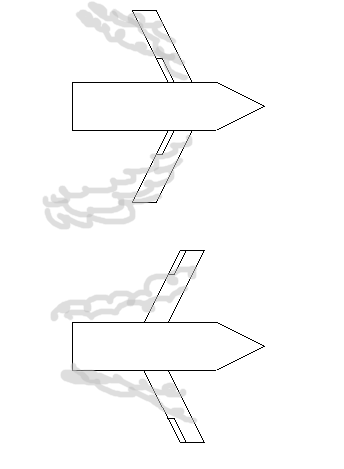|
Stardate
20030128.1333 (Captain's log): I look at the world through the eyes of a system engineer. Not surprising, really, since that what I am. It's not just what I do (or did) but actually deeply fundamental to the way I exist and think.
For most people, the subjective experience of thought is in words. For some it's in pictures. I do both and I can switch back and forth as need be depending on the kind of problem I'm trying to solve, because they have different strengths.
When I'm trying to look for underlying patterns, I mostly use picture thinking – which makes it rather hard here to express those patterns, since this is inherently a "word" communications medium, and I'm no artist. Not that being an artist would help, because the "pictures" aren't really pictures.
These are things which occur in many ways, but where the underlying pattern is identical. In a sense, the various manifestations are isomorphic. But to me some of those patterns are tangible things, almost old friends who pop up all over the place when I look for them.
About a year ago I described one of them in a sequence of essays. It ranged around and talked about such things as evolutionary competition, the computer industry, and ultimately some of the reasons for the war we're currently in. The underlying pattern was that many systems which involve competitive elements will reach a point of externally-imposed saturation, where the overall system growth slows. When that happens, there's a fundamental and permanent transition in the internal dynamic. Competitors in the system which survived and prospered while the overall system was growing will die after this transition. Absent a better term, I guess what I would say is that in many kinds of systems, shakeout is unavoidable. Beyond a certain point, weaker competitors will die out and the system will be dominated by a few strong competitors, often only one.
There are other patterns like that I see. For instance, there's one I've been thinking about for the last couple of days. When I hold it in one way and cast a mental shadow it looks like aircraft wings. When I hold it another way it looks like capitalism. Turn it again and it looks like rodents in Finland. Yet another shadow looks like the function of a healthy human heart. It may seem strange that all those things relate, but the underlying pattern is constant and I see it all over the place. Unfortunately, if there's a word for it I don't know what it is. The closest thing I can come up with is robustness, a term engineers use for certain kinds of systems, but that term also is used to refer to other things. But with nothing better, that's what I'll have to call it.
What you have in some systems is a tendency to self-correct. When the system is perturbed, the inherent forces of the system will eventually bring it back on track. Such a system is robust. The opposite case is a system which is fragile, which means that if the system is perturbed, the inherent forces tend to amplify the perturbation, and eventually the system collapses.
Take a pendulum. It's a stiff rod with a hinge at one end and a weight at the other. And consider two possible states of it:

On the left, the weight hangs directly below the hinge. On the right, it's balanced directly above it. Both states are stable. But if you slightly perturb the weight, they don't react the same way. When the left weight is moved off to the side, the force of gravity tries to center it again. In practice, if the hinge has a good bearing, the system then will oscillate around the base state and eventually stop back where it started. But if the right weight is perturbed, then gravity pulls the weight away and the right system will fail and convert to the left one.
The left state is robust. The right state is fragile. The left state responds to challenges by trying to maintain itself; the right state responds to challenges by shattering.
Have you ever wondered why it is that high speed aircraft have rear-swept wings? Why not front-swept? In fact, from the point of view of flight dynamics, front-swept wings are superior.

(An artist I ain't.) The wings cause turbulence vortices, and on rear swept wings they move outwards. That means that the control surfaces have to be near to the aircraft so that they're in smooth air flow. On front swept wings, the vortices tend to move inwards, so the control surfaces can be placed at the wing tips.
When the surfaces are further out, they have more leverage on the aircraft, which means they can be smaller. That means that when they're in use they cause less drag. With the surfaces are closer to the aircraft body, they have less leverage so they have to be larger, causing more drag. As a result, a jet with rear-swept wings will lose more speed when turning than one with front swept wings. So why are we using rear-swept wings?
The reason is that front-swept wings are equivalent to the top-balanced pendulum. When the wings flex a bit up or down, the forces tend to make the wing flex even further. Eventually the force becomes too great, and the wings tear off. Rear swept wings are like the hanging pendulum. When the wings flex, the force automatically tries to recenter them.
NASA actually produced an experime
|